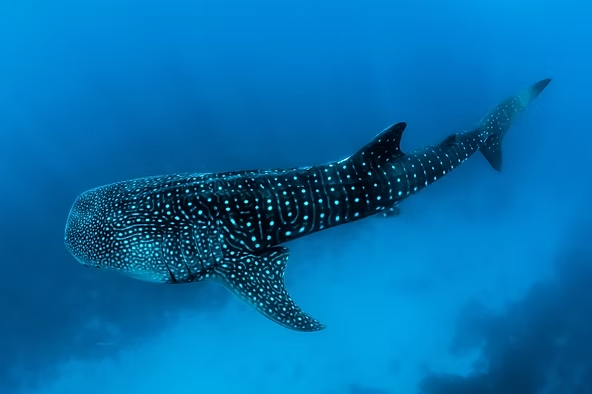About Whale Sharks
Whale sharks thrive in tropical climates and warm waters, spending most of their time in deeper areas about 150 feet below the surface. They are the largest fish in the world, reaching up to 40 feet in length and weighing as much as 20,000 pounds—the height of two giraffes stacked together and the weight of two elephants combined. Their three-foot-wide mouths contain more than 350 rows of teeth, yet they pose no threat to humans. Known as gentle giants, whale sharks sometimes benefit from remoras and pilot fish that remove parasites and bacteria from their massive bodies. Still, caution is advised around their powerful tails, which can cause serious injury.
Unique Features
- Spotted Pattern: Each whale shark has distinctive white, yellow, and gray spots arranged in a checkerboard pattern, much like human fingerprints.
- Sixth Sense: Through the Ampullae of Lorenzini, whale sharks detect electromagnetic fields emitted by other animals, giving them an extraordinary sensory advantage.
Whale or Shark?
Despite their name, whale sharks are not whales. They are indeed sharks, making them fish rather than mammals. They are closely related to the bottom-dwelling wobbegong shark—an unusual name that is almost as fun to say as it is to learn about.
Status and Conservation
Whale sharks typically roam the ocean alone, but when plankton is abundant, they gather to feed. Their primary feeding method is filter feeding—swimming with mouths wide open to capture plankton suspended in the water. Along with plankton, their diet includes squid, krill, and small fish. These gatherings provide incredible opportunities for marine researchers and conservationists to observe and learn more about these magnificent creatures.
Conservation Awareness
Although whale sharks are peaceful, their populations face challenges from environmental threats and human activity. Conservation efforts focus on raising awareness, protecting feeding grounds, and educating communities about the vital role whale sharks play in maintaining ocean ecosystems. By understanding and protecting them, we help preserve not just a species, but an essential balance in marine life.

